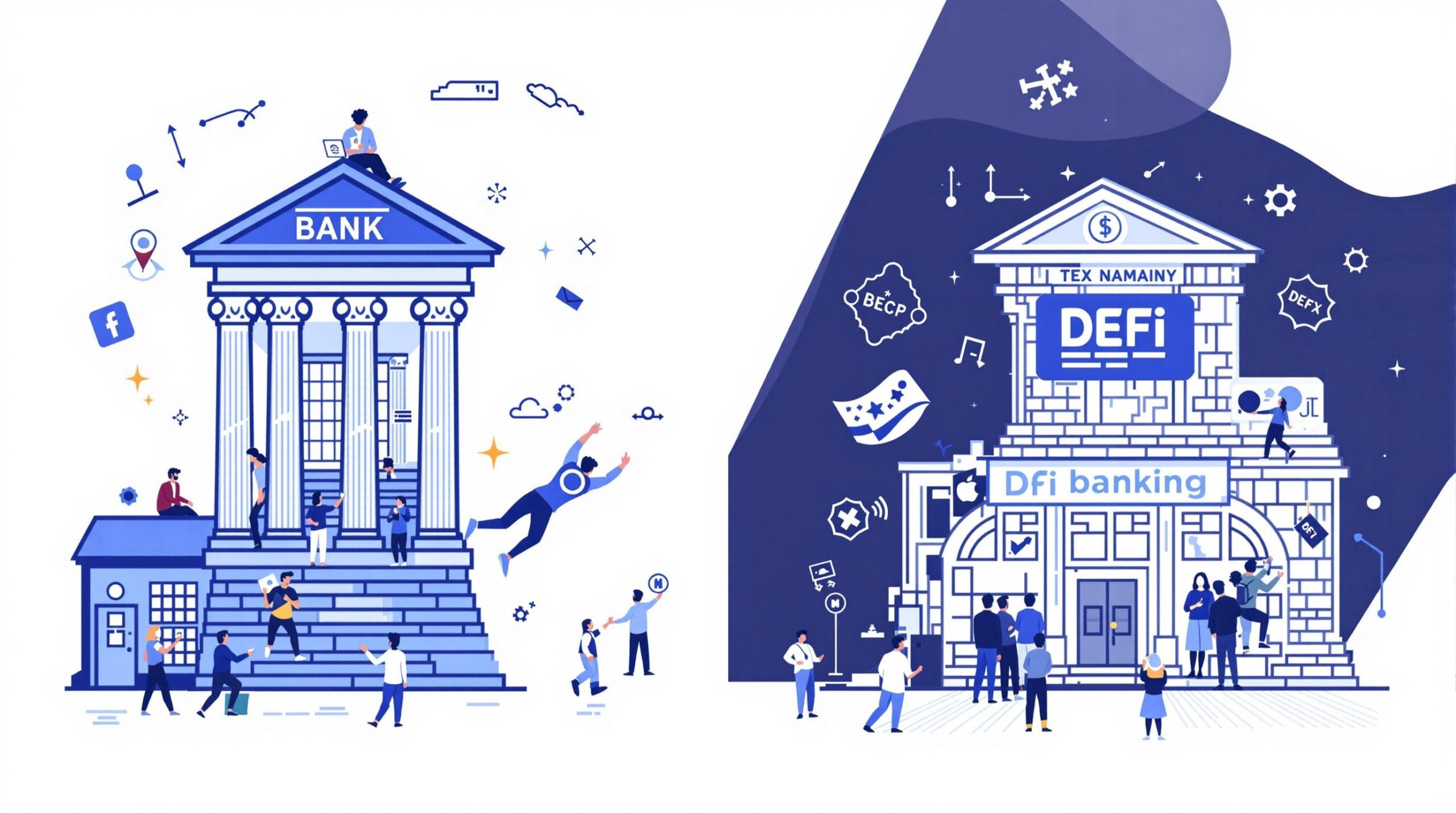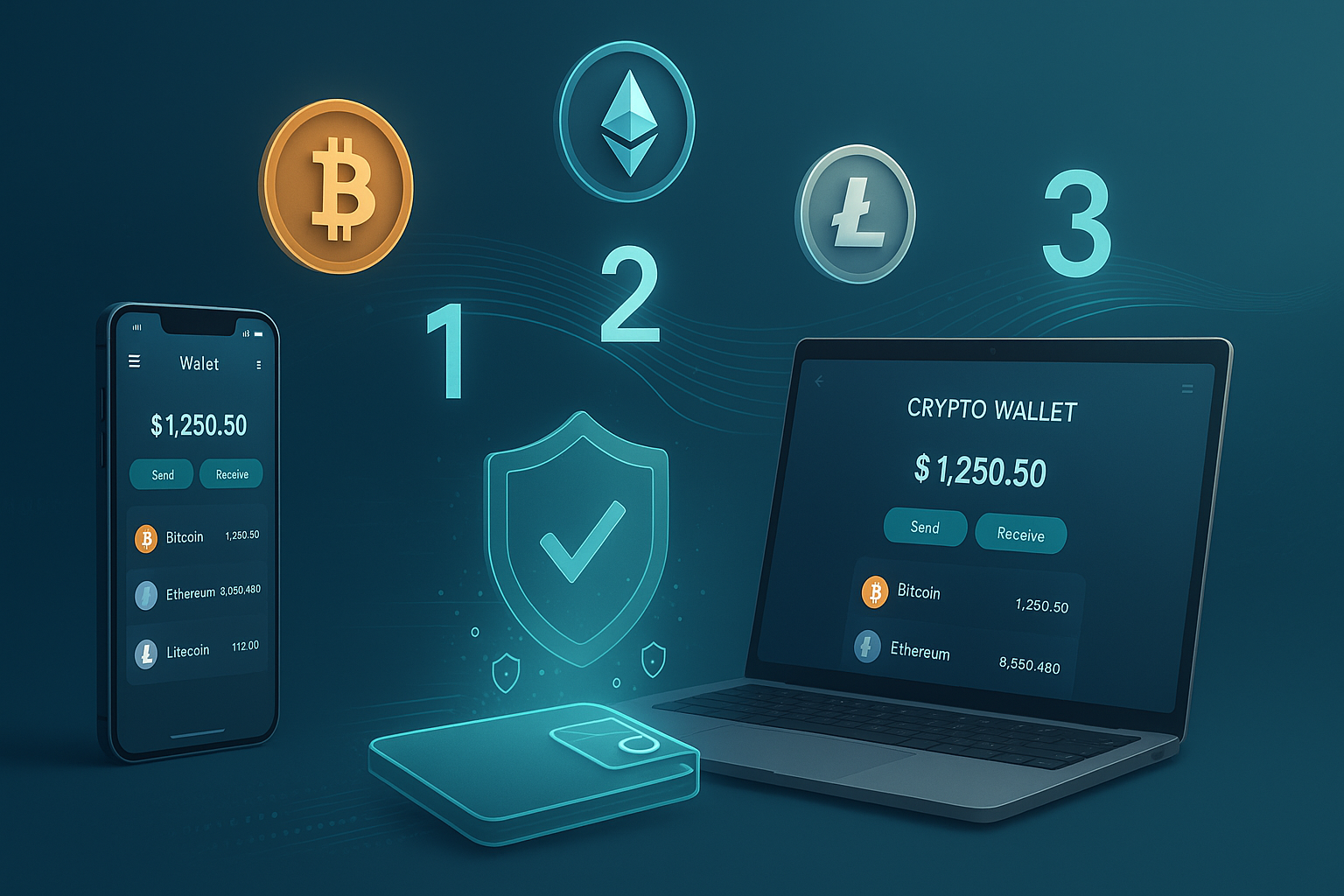Dive into the decentralized revolution. From Bitcoin and Ethereum to DeFi protocols, NFTs, and Web3 advancements, we explore how blockchain is redefining trust, ownership, and value exchange in the digital age.
Decentralized Finance (DeFi) challenges the fundamental structures of global banking by leveraging blockchain technology to remove intermediaries and automate financial services through code. The stark contrast between DeFi vs traditional banking reveals not just technological differences but fundamentally different approaches to asset control, accessibility, costs, and transaction speeds that are reshaping how we think about money management.
Key Takeaways
- DeFi manages $190 billion in assets compared to traditional banks’ $160 trillion, but offers direct asset control through private keys
- Traditional banking serves 54% of developing-world adults while DeFi has reached 151 million users with minimal access requirements
- DeFi fees are typically 90% lower than traditional bank charges for comparable services
- Transaction settlement in DeFi occurs in seconds or minutes versus 2-6 business days for traditional bank transfers
- Real World Asset tokenization represents an $18.9 trillion opportunity by 2033, bridging DeFi and traditional finance
The Fundamental Divide: Control and Governance
The core difference between DeFi and traditional banking lies in their governance structures and control mechanisms. Traditional banks operate as centralized entities, where decisions flow from top management while adhering to governmental regulations like those from the FDIC. JPMorgan Chase, for example, must follow strict compliance rules for every transaction they process.
In contrast, DeFi protocols operate through smart contracts and blockchain technology without human intermediaries. The Aave protocol enables peer-to-peer lending entirely through automated code that cannot be altered without community approval. This fundamental distinction affects everything from asset custody to operational transparency.
The scale difference remains substantial: while DeFi’s Total Value Locked (TVL) reached $190 billion in 2024, with protocols like Aave ($40.3B) and Lido ($14.6B) leading the pack, traditional banks still control approximately $160 trillion in assets. However, this gap is narrowing as more users seek to understand blockchain technology and its financial applications.

Accessibility Revolution: Breaking Down Barriers
Traditional banking requires physical infrastructure and identity verification that creates significant barriers to entry. Users typically need government ID, proof of address, and often minimum deposits to open accounts. Despite global efforts to improve financial inclusion, only 54% of adults in developing countries have bank accounts.
DeFi has fundamentally changed this equation by requiring only internet access and a cryptocurrency wallet. This minimal barrier has helped DeFi reach 151 million unique users in 2024, representing a remarkable 196% year-over-year increase. Creating a cryptocurrency wallet takes minutes compared to the days or weeks needed for traditional bank account approval.
The demographic breakdown of DeFi users reveals interesting patterns:
- 70% male, primarily in the 25-44 age group
- Geographic distribution: North America (35%), Europe (30%), Asia (25%)
- Complemented by 2 billion mobile money accounts processing $1.68 trillion in 2024
This accessibility has created opportunities for the 2 billion adults globally who remain unbanked, offering financial services without traditional gatekeepers.
Fee Structures: The 90% Advantage
The cost difference between DeFi and traditional banking represents one of the most compelling arguments for decentralization. Traditional banks charge substantial fees for services that DeFi provides at a fraction of the cost:
- International wire transfers: $0-$65 at banks vs. 0.3-2% in DeFi
- Domestic transfers: $15-$40 at banks vs. minimal gas fees in DeFi
- Account maintenance: Monthly fees at banks vs. no ongoing costs in DeFi
This fee discrepancy explains why DeFi has gained traction for cross-border transactions and remittances. Despite DeFi’s fee advantage, the sector’s revenue dropped to $419 million in 2024 (compared to $6.2 billion in 2021), while the top 1,000 banks generated $1.27 trillion in net profit.
The yield opportunities in DeFi also typically outpace traditional banking, with many protocols offering APYs above 5% for dollar-pegged assets, compared to the sub-1% rates common at traditional banks. However, DeFi revenue per user has declined to $7.9 in 2024, suggesting increasing competition within the space.
Transaction Speed: From Days to Seconds
Transaction settlement speed represents another fundamental advantage of DeFi systems. Traditional banking relies on aging infrastructure like the Automated Clearing House (ACH) system, which typically takes 2-6 business days to complete transfers. Even “same-day” ACH still requires 1-2 business days for full settlement.
In contrast, Ethereum-based DeFi transactions typically settle in 13 seconds to 5 minutes, while Layer 2 solutions like Optimism and Arbitrum can be even faster. This speed difference isn’t just about convenience—it fundamentally changes financial possibilities by enabling high-frequency trading, real-time payments, and micro-transactions that wouldn’t be economically viable in traditional systems.
The volume processed through DeFi demonstrates its growing capacity:
- $1.76 trillion processed via decentralized exchanges in 2024
- Ethereum TVL reaching $77.15 billion in 2025
- Real-time settlement of complex financial transactions
For users seeking to manage digital assets, finding secure cryptocurrency wallets has become essential to participate in this high-speed financial ecosystem.
Security Evolution: Improving Trust
Security concerns have been a significant barrier to DeFi adoption, but recent trends show substantial improvements in protocol safety. DeFi lost $474 million to hacks in 2024, representing a 40% year-over-year decrease, with bridge exploits falling to $114 million.
Traditional banks rely on government-backed insurance (like FDIC) and centralized security controls. While this provides certain protections, centralized finance (CeFi) breaches actually surged to $694 million in 2024, highlighting that centralization doesn’t guarantee security.
The security landscape continues to evolve through:
- Smart contract audits becoming standard practice for serious DeFi protocols
- Implementation of multi-party computation (MPC) and zero-knowledge proofs
- Access control improvements after these vulnerabilities caused 50% of 2024 DeFi losses
- Insurance models specifically designed for DeFi risks
Both systems face distinct security challenges, but DeFi’s transparent code and open auditing processes allow for community-driven security improvements that are rapidly advancing the field.
The $18.9 Trillion Opportunity: Tokenization Bridge
Real World Asset (RWA) tokenization represents the most promising convergence point between DeFi and traditional finance. This process involves representing traditional assets like real estate, bonds, and commodities as digital tokens on blockchain networks.
The growth potential is staggering:
- $50 billion in tokenized assets in 2024
- Projected growth to $18.9 trillion by 2033
- $24 billion in tokenization projects currently in development
This bridge is also helping address financial inclusion gaps. Currently, only 35% of DeFi users come from North America, with women (30%) and older adults (5%+) underrepresented. RWA tokenization creates opportunities for fractional ownership of previously inaccessible assets like commercial real estate or fine art.
Institutional adoption is accelerating through protocols like Aave, Maple, and Maker, which are specifically designed to attract institutional capital while maintaining decentralization principles.
Revenue Reality: The Efficiency Gap
Despite DeFi’s technological advantages, traditional banking maintains a massive revenue advantage. The contrast is striking:
- DeFi sector revenue: $419 million in 2024
- Traditional bank profits: $1.27 trillion
- DeFi revenue per user: $7.9
Top DeFi protocols like Aave ($40.3B TVL), Lido ($14.6B), and EigenLayer ($6.9B) demonstrate significant capital efficiency, but traditional banks benefit from centuries of accumulated wealth, regulatory advantages, and established customer relationships.
Bank profit streams primarily come from interest rate spreads, account and service fees, and cross-selling of financial products. These generated $268.2 billion in net income for banks in 2024, dwarfing DeFi revenues. However, DeFi’s efficiency advantage suggests that as adoption increases, the revenue gap may narrow significantly.
The Future Landscape: Convergence and Growth
The future relationship between DeFi and traditional banking appears to be trending toward strategic convergence rather than complete replacement. Several key trends are shaping this evolution:
- Bitcoin ETF inflows exceeded $100 billion in 2024, driving broader DeFi adoption
- Bitcoin staking and AI integration emerging as new DeFi growth catalysts
- Traditional banks exploring blockchain for settlement efficiency
- DeFi protocols developing features specifically for institutional players
The TVL trajectory for DeFi is approaching all-time highs at $130 billion in 2024, with institutional protocols leading growth. Meanwhile, RWA tokenization is forecasted to grow from $0.6 trillion in 2025 to $18.9 trillion by 2033, creating substantial overlaps between traditional and decentralized finance.
This evolution suggests a future where the strengths of both systems are leveraged: DeFi’s efficiency, accessibility, and innovation combined with traditional finance’s regulatory clarity, scale, and trust mechanisms.
Sources
tangem.com – Total Value Locked (TVL)
focusonbusiness.eu – Total Value Locked in DeFi Soars 137% YoY
cointelegraph.com






